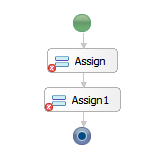Vitaly,
The case(1) below in the BPEL editor is actually handled by a hidden
sequence.
If you wipe out a the main activity in the process, then add an assign
and another assign after it, you see something like this.

But what the source has is this....
<bpws:sequence name="HiddenSequence">
<bpws:assign name="Assign" validate="no"/>
<bpws:assign name="Assign1" validate="no"/>
</bpws:sequence>
Hidden sequence are not displayed currently, which is confusing
perhaps.
I would actually vote to implement this a little differently, but sort
of in the same way.
a) If a placeholder calls for an single activity and you are dropping
another activity where one already exists, then wrap it in the sequence
but don't make it hidden, that is expose it.
b) If you dropping another activity as the new main activity (the arrow
after the start node), then make the new activity the first activity in
the sequence if a sequence already exists (don't re-wrap). This would
solve the mystery hidden sequence problem that you have stumbled upon.
In a baseline BPEL 2.0 implementation, I would rather stray away from
such UI tricks (like hidden sequences).
-michal
Tishkov, Vitaly V wrote:
_______________________________________________
bpel-dev mailing list
bpel-dev@xxxxxxxxxxx
https://dev.eclipse.org/mailman/listinfo/bpel-dev
--
Michal Chmielewski, CMTS, Oracle Corp,
W:650-506-5952 / M:408-209-9321
"Manuals ?! What manuals ? Son, it's Unix, you just gotta know."
|

